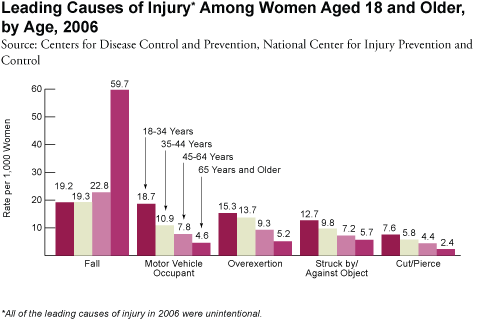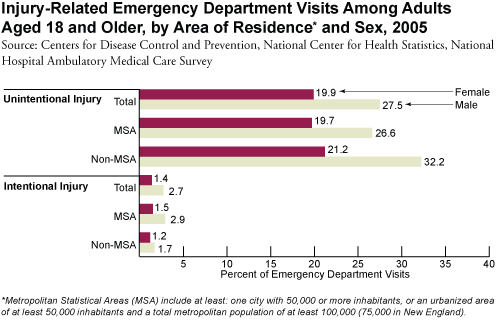Injury
Often, injuries can be controlled by either preventing an event (such as a car crash) or lessening its impact. This can occur through education, engineering and design of safety products, enactment and enforcement of policies and laws, economic incentives, and improvements in emergency care. Some examples include the design, oversight, and use of child safety seats and seatbelts, workplace regulations regarding safety practices, and tax incentives for fitting home pools with fences.
In 2006, unintentional falls were the leading cause of nonfatal injury among women of every age group, and rates generally increased with age. Women aged 65 years and older had the highest rate of injury due to unintentional falls (59.7 per 1,000 women), while slightly more than 19 per 1,000 women aged 18–34 and 35–44 years experienced fall-related injuries. Unintentional injuries sustained as motor vehicle occupants were the second leading cause of injury among 18- to 34-year-olds (18.7 per 1,000), while unintentional overexertion was the second leading cause of injury among women aged 35–44 and 45–64 years (13.7 and 9.3 per 1,000, respectively). Among women aged 65 years and older, being unintentionally struck by or against an object was the second leading cause of injury (5.7 per 1,000).
Unintentional and intentional injuries each represented a higher proportion of emergency department (ED) visits for men than women in 2005. Among women and men aged 18 years and older, unintentional injuries accounted for 19.9 and 27.5 percent of ED visits, respectively, while intentional injuries, or assault, represented 1.4 and 2.7 percent of visits, respectively. Among both women and men, unintentional injury accounted for a higher percentage of ED visits among those living in non-metropolitan areas, while adults living in metropolitan areas had a slightly higher percentage of ED visits due to intentional injury.




No comments:
Post a Comment